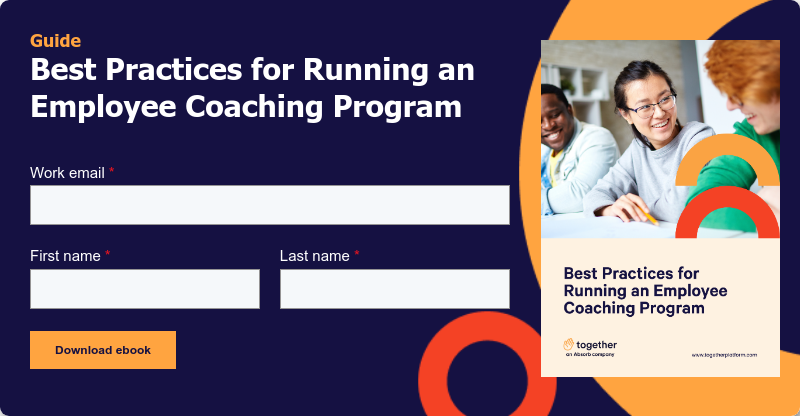Coaching is one of the most powerful tools in HR’s toolkit. Our own research found that 80% of HR professionals believe coaching and mentoring are the keys to performance. At the same time, according to data from DDI, 40% of leaders say they don’t get enough coaching from their manager, and 31% of frontline leaders want more coaching than they’re currently getting.
Whether you’re guiding a high-potential employee toward a leadership role or helping a team member overcome a performance challenge, coaching builds trust, clarity, and momentum. But the most effective coaching isn’t done off the cuff—it’s structured, intentional, and well-documented.
This is where an employee coaching template becomes invaluable.
In this guide, we’ll walk through why employee coaching plans matter, how to structure a coaching session, and best practices for documenting coaching conversations in a way that drives long-term employee engagement and growth.
What is a coaching plan template (and why do you need one)?
A coaching plan template is a repeatable format managers and HR professionals can use to prepare for and lead coaching sessions. It typically includes sections for setting goals, tracking progress, documenting action items, and identifying roadblocks or support needs.
But why use one?
Because consistency matters.
Without a plan, coaching can become reactive instead of proactive. You might spend valuable one-on-one time discussing surface-level issues instead of digging into what’s actually going to help the employee grow. A template makes sure every session covers the right ground while giving structure to the employee’s development journey.
Key benefits of using a coaching plan template:
- Aligns coaching with business and employee goals
- Ensures consistency across teams and managers
- Creates a record of development progress for performance reviews
- Supports accountability for both the coach and the employee
- Makes it easier to identify trends, obstacles, or training needs across teams
How to structure an employee coaching session
A good coaching session is a balance of strategic planning, active listening, and collaborative problem-solving. Structuring your sessions with a consistent framework helps you stay focused and productive, whether you’re meeting biweekly or quarterly.
Basic components of an employee coaching plan
- Session Objective: What’s the goal of today’s conversation? This might be tied to a broader development goal or a current performance issue.
- Progress Check-In: How has the employee been doing since the last session? Review prior goals, wins, setbacks, and progress on action items.
- Discussion Topics: What challenges or opportunities are top of mind? Let the employee bring items forward too—coaching should be a two-way dialogue.
- Skill Development or Goal Alignment: Explore specific competencies the employee wants to develop. Use this time to map goals to business needs or long-term career interests.
- Action Items: Agree on concrete next steps, timelines, and ownership. These should be achievable and measurable.
- Support Needs: Identify any training, resources, or support the employee needs to succeed between sessions.
- Session Notes and Reflections: Summarize key takeaways from the session—what worked, what needs attention, and how the employee felt about the conversation.
This structure keeps things focused and actionable, while also giving space for deeper coaching moments that often arise naturally in the dialogue.
How to write a coaching plan for an employee
Creating a coaching plan is about meeting employees where they are—and guiding them to where they want to go.
Here’s a step-by-step process:
1. Start with the end in mind
What are you and the employee trying to achieve? Tie coaching goals to both personal career aspirations and organizational needs. Are they working toward a promotion? Improving communication with peers? Navigating a new project or responsibility?
Example Goal: Improve stakeholder communication to increase visibility and buy-in on cross-functional initiatives.
2. Assess the current state
Use feedback, performance data, or employee self-assessments to understand where the employee stands today. This helps clarify gaps and opportunities.
Example Current State: Employee often provides project updates reactively rather than proactively. Feedback from peers indicates that communication feels last-minute.
3. Identify development areas and objectives
Break down the larger goal into focused areas to work on. These should be achievable, clear, and time-bound.
Example Development Focus: Deliver regular written updates to stakeholders every Friday. Prepare talking points ahead of team meetings.
4. Outline action steps
Include specific actions the employee can take between sessions. Make sure each one is measurable and aligned with the coaching goal.
Example Action Steps:
- Draft a weekly update template
- Schedule 15-minute check-ins with cross-functional leads
- Practice presenting updates in team meetings
5. Track progress and celebrate wins
Every coaching plan should include a place to record milestones. This helps you measure improvement over time and keep the employee motivated.
Examples of employee coaching questions
Great employee coaching questions are a part of any great employee coaching session template. A good coaching question can help coachees reflect, set goals, explore solutions, and take ownership of their growth. Here are some effective coaching questions grouped by stage of the conversation:
Goal-setting questions
- What do you want to achieve in the next 3–6 months?
- What does success look like for you in this role?
- How does this goal align with your career aspirations?
- If you could improve one skill right now, what would it be?
Reality-checking questions
- What’s working well for you right now?
- What challenges are you currently facing?
- How do you think others perceive your performance?
- What’s holding you back from reaching your goal?
Exploration and options
- What are some possible ways you could approach this?
- Have you faced something similar before? What worked?
- What resources or support would help you move forward?
- If you weren’t limited by time or resources, what would you do?
Action-oriented questions
- What’s the first step you’ll take after this conversation?
- What will you do differently moving forward?
- How will you measure your progress?
- Who can help hold you accountable?
Reflection and growth
- What did you learn from this experience?
- How have you grown since we last spoke?
- What feedback have you received, and how did you act on it?
- What’s one thing you want to do better next time?
How to document employee coaching sessions (and why that’s important)
One of the most overlooked—but essential—aspects of coaching is documentation. And no, this doesn’t mean creating more paperwork for the sake of it.
Documenting coaching sessions helps coaches to:
- Create a historical record of development efforts
- Support performance management conversations with evidence
- Uncover patterns and themes across multiple employees
- Demonstrate the impact of coaching at scale
Equipping your coaches with a coaching plan template can make this documentation easy and seamless.
What should be documented?
You don’t need a transcript of every coaching conversation, but the following elements are helpful to capture:
- Date of session
- Session goals or focus areas
- Summary of discussion points
- Agreed-upon action items
- Any observed behavior changes or milestones
- Support provided by the manager or HR
You can use a shared document, HRIS system, or employee coaching software to keep everything organized and accessible. Ideally, the employee should have access too—transparency builds trust and reinforces ownership of their growth.
Tips for effective coaching documentation
Provide these best practices to your coaches when it comes to coaching documentation:
- Be objective: Stick to facts, agreed-upon actions, and observable behaviors.
- Keep it brief: Aim for concise summaries, not essays.
- Review regularly: Revisit past notes to guide future sessions and track progress.
5 employee coaching plan templates to get you started
We’ve curated a list of our favorite coaching plan templates for a variety of coaching scenarios.
1. Best general coaching plan template
This coaching plan template from Academy to Innovate HR covers everything we’ve talked about in this blog post, documenting key objectives, action steps, and a timeline. This general coaching plan is incredibly versatile for all types of coaching scenarios, like career progression coaching, succession planning coaching, and more.

2. Best mentoring and coaching plan template
Mentoring and coaching have their differences: coaching is goal-oriented, focusing on building specific skills, problem-solving, and performance management. Mentoring takes a broader approach of fostering long-term career and personal growth. However, the lines between the two aren’t always so distinct. A successful coaching relationship, originally developed to provide an employee with short-term tools, training, and feedback to develop a specific skill, might turn into a long-term mentoring relationship, or vice versa.
In those scenarios, these 5 mentoring session agenda templates can help drive structured mentoring conversations around personal development, collaboration, teamwork, and more.

3. Best coaching plan template for employee performance
The experts agree—it’s time to replace performance improvement plans with coaching plans. This employee coaching plan template by PerformYard focuses on current performance and/or behavior, desired performance and/or behavior, and an action plan on how to meet those objectives, including supervisor support. Download the template here.
4. Best GROW coaching plan template
The GROW coaching model (which stands for Goal, Reality, Options, and Will) is one of the most popular and practical frameworks for structuring coaching conversations. It provides a simple, goal-oriented approach that helps individuals move from where they are to where they want to be, by exploring goals, current reality, options, and a way forward.
SampleTemplates has already curated a list of 10 GROW coaching plan templates for different coaching use cases. Check them out here.

5. Best coaching plan template for employee growth and career development
For those who operate more visually, Miro’s employee growth plan is a great resource that can drive coaching conversations. This coaching plan template is specifically designed to trigger self-awareness through activities, build habits of capturing thoughts and ideas and turning them into action, and how to stay aligned with business goals by tracking progress along a performance cycle.

Elevate your coaching program with an employee coaching template
When you make coaching part of your management rhythm—not an ad hoc performance fix—it becomes a powerful force for engagement, retention, and growth.
A coaching plan template won’t do the coaching for you, but it gives you the structure and clarity to do it better. And when you approach coaching with a clear plan, your employees will feel the difference: more supported, more empowered, and more committed to their growth and your organization’s success.
Whether you’re an HR professional designing coaching programs across your organization or a frontline manager guiding your team through change and development, now’s the time to bring more structure and intention to your coaching.
Starting your own coaching program? Check out our guide: Best Practices for Running an Employee Coaching Program.



.svg)









